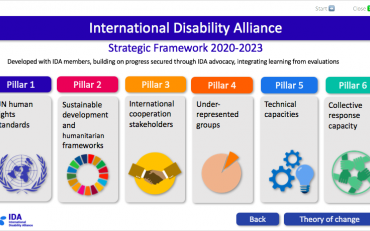IDA Strategic Framework 2020-2023
Date: November 2020
Since the entry into force of the Convention on the Rights of Persons with Disabilities (CRPD) in December 2006, progress has been made in raising awareness on the situation of persons with disabilities and in calling for a shift of paradigm considering persons with disabilities as subjects of human rights on an equal basis with others. The CRPD is increasingly known and called for as a framework of reference and contributed to change the perception of disability and persons with disabilities. Thanks to the advocacy efforts of IDA, its members and allies who seized every opportunity to open the doors, this has started to translate into greater visibility, reflected in prominent commitments such as the 2030 Agenda and its pledge to leave no one behind from development efforts.
The past five years have indeed been marked by unprecedented commitments such as those taken by world leaders at the first-ever Global Disability Summit, the first-ever United Nations Disability Inclusion Strategy, or the first-ever UN Security Council resolution specific to persons with disabilities in responses to armed conflict. Key mechanisms and networks are being set providing a stronger ground for discussing and strategizing the work towards realising disability-inclusive development, OPDs are gaining space to influence decision-making at high levels. At the global level, the question is now much less whether to include persons with disabilities, but how to do this in all sectors, all regions, for all persons with disabilities.
While these are very positive developments, much remains to be done to ensure that the human rights of persons with disabilities, enshrined in the Convention on the Rights of Persons with Disabilities (CRPD), are effectively realised. The diversity of recommendations from the CRPD Committee through its reviews of reports from low- and middle-income countries testifies to the range of issues that still need to be addressed to ensure non-discrimination and inclusion of persons with disabilities. Persons with disabilities still face pervasive inequalities in terms of access to education, employment or health outcomes, which are experienced even more acutely by most marginalised groups, such as persons with psychosocial disabilities, persons with intellectual disabilities, persons with deafblindness, women and children with disabilities. In specific areas, there are also worrying trends of practices seriously contravening the CRPD, such as coercive healthcare approaches.
This new strategic framework of IDA is the result of a participatory process of reflective learning, analysis of current opportunities and risks, and strategizing the priorities of the diverse constituencies that form our alliance. It proposes a bold and ambitious plan that we believe is needed to be at the level of what is at stake: no more and no less than the rights of 1 billion persons with disabilities worldwide. It entails continued efforts to uphold the CRPD standards, hold key stakeholders accountable, and enhance their political will and technical capacity to deliver on their commitments (pillars 1, 2, 3). It also entails a strong investment to develop the disability rights movement’s capacity to represent, coordinate its voice and contribute meaningfully (pillars 4, 5, 6). For this strategy to be successful, we will need the active involvement of all our constituencies, but also the support of our allies, partners and donors. We have a collective responsibility to leave no person with disability behind, and count on your collaboration and on solid partnerships to take up this challenge.
Ana Lucia Arellano,
President of the International Disability Alliance
>> Download here the summary presentation of our Strategy for 2020-2023
